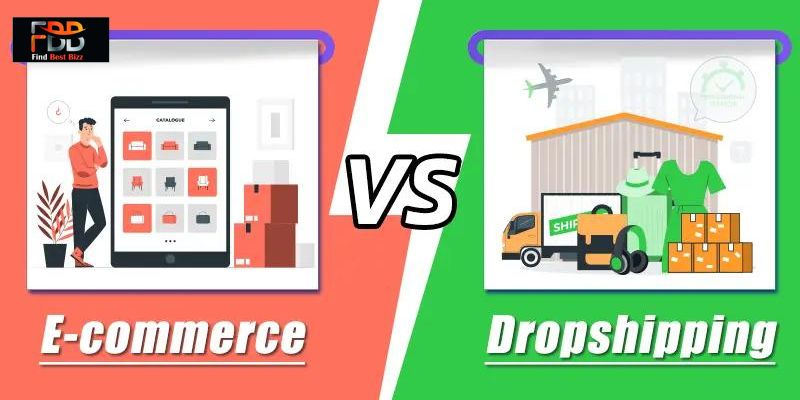In the dynamic world of online business, choosing the right model is crucial for your success. Two popular options that often come up in this discussion are traditional ecommerce vs dropshipping. Both have their merits and drawbacks, and selecting the one that aligns with your goals and resources is essential. In this article, we will delve into the differences between ecommerce vs dropshipping to help you make an informed decision in 2023.
What is Ecommerce?
Ecommerce, short for electronic commerce, refers to the buying and selling of goods and services over the internet. In a traditional ecommerce model, the business owner stocks inventory, manages the website, and fulfills orders directly to customers. This approach has been the cornerstone of online retail for many years and offers full control over the entire process.
What is Dropshipping?
Dropshipping is a business model where you don’t keep products in stock. Instead, you partner with suppliers who handle inventory and shipment on your behalf. When a customer places an order, the supplier ships the product directly to the customer. This model eliminates the need for inventory management and reduces upfront costs, making it an attractive option for entrepreneurs.
Ecommerce vs. Dropshipping: A Comparative Analysis
Let’s explore the critical factors that differentiate ecommerce and dropshipping:
Business Model
- Ecommerce:
- Traditional model where you purchase and stock inventory.
- You have complete control over product selection and quality.
- Greater responsibility for order fulfillment and customer service.
- Dropshipping:
- No need to purchase or stock inventory.
- Reliant on suppliers for product availability and quality.
- Less hands-on involvement in fulfillment and customer service.
Inventory Management
- Ecommerce:
- Requires space and resources for inventory storage.
- Full control over product availability and restocking.
- Potential for overstocking or understocking.
- Dropshipping:
- No need for inventory storage, reducing overhead costs.
- Relies on suppliers to manage inventory levels.
- Eliminates the risk of overstocking but may lead to occasional stockouts.
Initial Investment
- Ecommerce:
- Typically higher upfront costs due to purchasing inventory and setting up storage facilities.
- Greater financial risk involved in stock purchase.
- Dropshipping:
- Lower initial investment as you don’t need to buy inventory.
- Reduced financial risk, making it accessible to those with limited capital.
Product Variety
- Ecommerce:
- Complete control over product selection and branding.
- Freedom to create a unique product catalog.
- Ability to bundle, customize, or personalize products.
- Dropshipping:
- Limited control over product variety, as it depends on supplier offerings.
- May face competition from other dropshippers selling the same products.
- Difficult to differentiate through product selection alone.
Fulfillment and Shipping
- Ecommerce:
- Full control over order fulfillment and shipping.
- Ability to offer diverse shipping options and packaging.
- Can optimize shipping times and costs.
- Dropshipping:
- Relies on suppliers for fulfillment and shipping.
- Limited control over shipping times and packaging.
- Potential for longer delivery times and less control over the shipping process.
Control and Branding
- Ecommerce:
- Full control over branding, website design, and customer experience.
- Ability to build a strong brand identity.
- Direct interaction with customers, fostering brand loyalty.
- Dropshipping:
- Limited control over branding and customer experience.
- Brand identity relies heavily on marketing efforts.
- Indirect customer interaction through suppliers.
Frequently Asked Questions (FAQs)
1. Can I switch from ecommerce to dropshipping or vice versa?
Yes, it’s possible to transition between the two models, but it requires careful planning and adjustments to your business strategy.
2. Which model is more cost-effective in the long run?
Dropshipping generally has lower initial costs, but long-term profitability depends on factors like product margins, marketing effectiveness, and operational efficiency.
3. Are there any legal or tax differences between ecommerce and dropshipping?
Both models may have legal and tax considerations that vary by location and business structure. Consult with legal and financial professionals for guidance.
4. Can I combine both models in my business?
Yes, some entrepreneurs choose to incorporate both ecommerce and dropshipping to offer a wider range of products and enhance their business flexibility.
5. Which model is better for beginners in 2023?
For beginners with limited capital and experience, dropshipping may be a more accessible entry point into online business. However, thorough research and planning are essential.
Conclusion
Ecommerce vs Dropshipping is a critical decision for anyone entering the online business world in 2023. Each model has its advantages and challenges, and the right choice depends on your resources, goals, and preferences. Ecommerce offers greater control but requires more significant upfront investment, while dropshipping lowers barriers to entry but comes with limited control over product quality and fulfillment. Carefully assess your circumstances and business strategy to determine which model aligns best with your vision for success in the ever-evolving world of online commerce.
Read also: 5 Best Dropshipping Suppliers for Amazon
